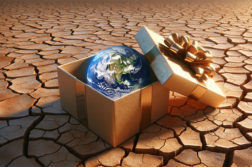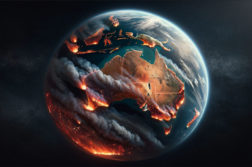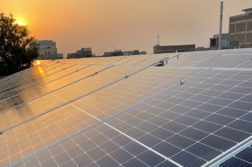When the world renowned climate scientist, James Lovelock, declares that catastrophe is inevitable and the world’s population will be reduced by 80 per cent by the end of this century, it is probably time to think about either heeding his advice and partying hard, or spending what time there is left trying to achieve a different outcome.
Unlike Lovelock’s prophesy, the language of the Intergovernmental Panel on Climate Change (IPCC) reports is by necessity cool and calm. The numbers, percentages and statistics suggest an imaginable world of cause and effect, a future and a planet we can all do business with – after we’ve switched to renewable fuel and planted a few more trees.
This is not to suggest the authors of the reports are relaxed and comfortable about what their modelling tells them. As the Bali Declaration suggests, quite the opposite is true.
No, the illusion of manageability and containment is maintained by our collective refusal – or inability – to front up to the implications of the numbers. How much hope do we hold for adoption of the 90 per cent emissions reductions recommended by the Garnaut Climate Change Review? And further, given there is now at least a 1.7 degree increase in temperature built into the system, whatever we do about carbon emissions, how will China, India and Africa feed their people? And with the projected decrease in rainfall, loss of glacier run-off and increase in evaporation, where will their water come from?
For some, these are questions for today, not tomorrow. For the Dalits of India, the Rakhain fishing community in Bangladesh, the pastoralists of Kenya and the Afro-Colombians in Colombia, climate change is already a brutal reality they are struggling to live with. As are the citizens of Tuvalu, Darfur and Uganda, who are already dealing with water supplies contaminated by saltwater, reduced herds due to drought and, in Darfur, a resource war that is daily redefining horror.
The time is fast approaching when the West too will struggle with the impacts of climate change on access to resources we take for granted. Unfortunately, history teaches us that if we wait until resources are stressed or disappearing, despair and fear will determine our actions, not our collective will or humanity. Therefore the time for thought, reflection and action is now.
Having finally rejoined the international community last December, Australia will spend the next two years locked in climate change negotiations to create a post-2012 agreement. The Rudd Labor Government has said it wants an international agreement that is "equitable and efficient".
This is all to the good. The carbon dioxide content of the world’s atmosphere is now at 385 parts per million (ppm). To have a 50/50 chance of avoiding more than a 2 degree increase in the world’s temperature, the carbon in the atmosphere needs to not exceed 450ppm. However, with all the indicators going in the wrong direction – carbon emissions are not declining or even stabilising, but rather surging – the chances of achieving stabilisation at 450ppm is extremely unlikely.
This is why the post-2012 international agreement, while important, needs to be run in parallel with the development of international agreements that assert and reinvigorate the basic human rights of all citizens, whether their particular nation state survives the coming climatic conditions intact or not.
Current scientific modelling draws into question the ongoing viability of many nation states in light of a 2 degree plus global temperature increase. Examples of some projected regional impacts by the IPCC include:
Africa: by 2020, between 75 and 250 million of people are projected to be exposed to increased water stress due to climate change. By 2020, in some countries, yields from rain-fed agriculture could be reduced by up to 50 per cent. Agricultural production – including access to food – in many African countries is projected to be severely compromised, exacerbating food security and malnutrition. A situation the citizens of Darfur know only too well.
Asia: by the 2050s, freshwater availability in Central, South, East and South-East Asia, particularly in large river basins, is projected to decrease. Coastal areas, especially heavily populated mega delta regions in South, East and South-East Asia, will be at greatest risk due to increased flooding from the sea and, in some mega deltas, flooding from the rivers. Climate change is projected to compound the pressures on natural resources and the environment associated with rapid urbanisation, industrialisation and economic development.
Europe: climate change is expected to magnify regional differences in Europe’s natural resources and assets. Negative impacts will include increased risk of inland flash floods and more frequent coastal flooding and increased erosion (due to storms and sea level rise). Mountainous areas will face glacier retreat, reduced snow cover and extensive species losses (in some areas up to 60 per cent under high emissions scenarios by 2080). In southern Europe, climate change is projected to reduce water availability, hydropower potential, summer tourism and crop productivity – and increase heat waves and the frequency of wildfires.
Latin America: by 2050, increases in temperature and associated decreases in soil water are projected to lead to gradual replacement of tropical forest by savannah in eastern Amazonia. There is a risk of significant biodiversity loss through species extinction in many areas of tropical Latin America. Productivity of some important crops is projected to decrease and livestock productivity to decline. Overall, the number of people at risk of hunger is projected to grow. Changes in precipitation patterns and the disappearance of glaciers are projected to significantly affect water availability for human consumption, agriculture and energy generation.
It is the human response to these projections that will drive the destabilisation of international relations and test our collective capacity for co-operation. This is why the human rights system has so much to offer by way of preventative work – and why the science needs to inform the development of a reinvigorated and globalised human rights agenda.
If climate change is even partially as destructive as we suspect, the foundation of national sovereignty – territorial integrity – is about to be challenged by new forces.
Previously, territorial integrity was at most risk from armed forces. But the nation state may now be at risk from natural forces and the response of its citizens. The nation state and its population may be transformed by climate events that make the state meaningless, reducing social groupings to collections of individuals.
In such circumstances, we need to ask ourselves: who becomes responsible for the preservation of human rights?
The International
Covenant on Economic, Social and Cultural Rights, the International
Covenant on Civil and Political Rights and other treaties and human rights norms
which have acquired the status of customary international law and jus cogens provide important guidance on how we need to think about the basics of
life.
The marriage of science and human rights discourse has posed many challenges – particularly recently where genetic technologies race ahead of ethical and rights discussions – but a strong working relationship union between the two is necessary now.
As Professor Nicholas Stern suggests in his response to the Productivity Commission’s criticism of his Report: "Notions of rights, duties, vital needs and the virtues may all be relevant to the crucial question of what we ‘should’ do about climate change. More research, and the involvement of moral philosophers, would be welcome in this area."
Indeed it would.
This article has been updated from its original form for accuracy.
Donate To New Matilda
New Matilda is a small, independent media outlet. We survive through reader contributions, and never losing a lawsuit. If you got something from this article, giving something back helps us to continue speaking truth to power. Every little bit counts.



